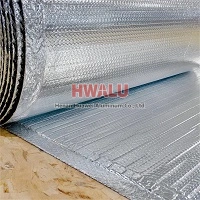In addition to cigarette packaging, the applications of aluminum foil in the packaging industry mainly include: aluminum-plastic composite bags, pharmaceutical aluminum foil blister packaging and chocolate packaging. Some high-end beers are also wrapped in aluminum foil on the bottle mouth. Medical packaging Medicinal blister packaging includes medicinal aluminum foil, PVC plastic rigid sheet, heat-sealing pain ...
PTP aluminum Blister foil parameter Alloy 1235, 8011, 8021 etc Temper O( HO ), H18, etc Width 300mm, 600mm, etc Thickness OP: 0.5 - 1.5 g/m2 Aluminum foil: 20 micron ( 0.02mm ), 25 micron ( 0.025mm ), 30 micron ( 0.3mm ) etc HSL ( VC ):3 - 4.5 gsm Primer: 1gsm Surface treatment Laminated, printing, Single bright side, etc What is ptp aluminum blister foil ...
Understanding of Aluminium Foil Tape Aluminium foil tape, also known as aluminium foil tape, is a thin layer of metal foil (usually aluminium foil) with a strong adhesive material on one side. This combination of materials makes the tape very durable. Therefore, aluminium foil tape has many excellent properties and a wide range of applications. Characteristics of aluminium foil tape What are the advantages ...
Aluminum foil for grills Aluminum foil for grilling is a versatile tool used in outdoor cooking. Grill foil is a thin, flexible sheet of aluminum that can be placed over your grill grates to aid in various aspects of grilling. Advantages of aluminum foil for barbecue packaging Aluminum foil is often used for barbecue packaging and has the following advantages: 1. Thermal conductivity: Aluminum foil has ...
What is aluminum foil for stickers Aluminum foil is a flexible, lightweight material perfect for making stickers. You can use aluminum foil for decorations, labels, stickers, and more, just cut out and add adhesive. Of course, stickers made of aluminum foil may not be as durable as stickers made of other materials, because aluminum foil is prone to chipping and tearing. Also, you need to be careful when using ...
What is thick aluminum foil Thick aluminum foil refers to a special type of aluminum foil that is thicker than regular aluminum foil. Usually, the thickness of the thick aluminum foil is between 0.2-0.3 mm, which is much thicker than regular aluminum foil. Like conventional aluminium foil, thick aluminum foil also has excellent properties, such as high electrical conductivity, fire prevention, corrosion resis ...
ITEM SIZE (MM) ALLOY / TEMPER WEIGHT (KGS) ALUMINIUM FOIL, ID: 76MM, ROLL LENGTH: 12000 - 13000 meters 1 0.007*1270 1235 O 18000.00
The post-processing of aluminum foil is an important part of an enterprise, which is related to the yield of an aluminum enterprise and the profit point of the enterprise. The higher the yield, the higher the profit point of the enterprise. Of course, the yield rate must be controlled in every link, standardized operation, and sophisticated equipment and responsible leaders and employees are required. I don't und ...
Coated aluminum foil is formed after surface treatment on the basis of non-coated aluminum foil. In addition to the chemical composition, mechanical properties and geometric dimensions required by the above non-coated aluminum foil, it should also have good shape and shape. coating properties. 1. Plate type of aluminum foil: First of all, the production process of coated aluminum foil requires that the alum ...
Aluminum foil is a thin sheet of aluminum metal that has the following properties: Lightweight: Aluminum foil is very lightweight because aluminium metal itself is a lightweight material. This makes aluminum foil an ideal material during packaging and shipping. Good sealing: The surface of aluminum foil is very smooth, which can effectively prevent the penetration of oxygen, water vapor and other gases, s ...
Nowadays, many female companions attach great importance to beauty and skin care. Women who are busy with their lives and work often use facial masks for skin care, which can provide sufficient nutrients for the facial skin and make the skin healthier and more energetic. With the increasing demand for facial masks, many manufacturers now make and produce facial masks. In order to improve the storage time of facia ...
Is aluminum foil a good insulator? It is certain that aluminum foil itself is not a good insulator, because aluminum foil can conduct electricity. Aluminum foil has relatively poor insulation properties. Although aluminum foil has certain insulating properties in some cases, its insulating properties are not as good as other insulating materials. Because under normal circumstances, the surface of aluminum foi ...








